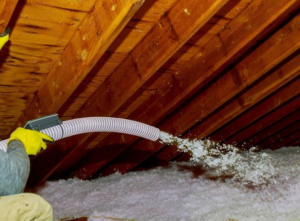How Much Insulation Do I Need in My Attic?
Nov 05, 2021 Most homeowners are aware that adding insulation to their attic is essential for creating a comfortable interior environment and improving the energy efficiency of their home. After all, you don’t want to have your HVAC system running around the clock, only for your attic to negate these effects. Having a properly insulated attic is essential for reducing strain on your HVAC system and promoting a consistent and comfortable temperature throughout your entire house. But how much insulation is really needed to accomplish the desired effect? We’re glad you asked.
Most homeowners are aware that adding insulation to their attic is essential for creating a comfortable interior environment and improving the energy efficiency of their home. After all, you don’t want to have your HVAC system running around the clock, only for your attic to negate these effects. Having a properly insulated attic is essential for reducing strain on your HVAC system and promoting a consistent and comfortable temperature throughout your entire house. But how much insulation is really needed to accomplish the desired effect? We’re glad you asked.
Is There a “Correct” Amount of Insulation for My Home?
While you may recognize that you need insulation in your attic, you may not be certain how much is right for your home. Too little insulation will be ineffective, wasting your money and not producing any noticeable improvements for your home. However, too much insulation is also a problem. It is possible to over-insulate your attic, resulting in your home not being able to “breathe.” If your home is too tightly sealed with insulation, ventilation can become a problem. Hot air won’t be able to escape your home, and moisture can build up inside, causing other problems. Therefore, you’ll need to find the happy medium of having enough insulation to have an effect, but not so much that it becomes counterproductive.
Understanding R-Values
Insulation is typically measured in R-value, which ranges from 2 to 8 per inch of insulation. The higher the R-value, the more insulating the material. The recommended R-value for attics, based on U.S. Department of Energy recommendations, is generally around R-38. Looking at the R-value of the insulation you plan to put in, you can do a simple calculation to determine how many inches of insulation you’ll need to put down.
More to Consider with Attic Insulation
So far, using R-values as a guide can make it easy to understand how much insulation is needed in your attic. However, that doesn’t necessarily mean you’re ready to purchase some insulation and handle the project on your own. You’ll also want to understand that there are different types of insulation and different uses for each. Most homeowners are familiar with the fluffy pink fiberglass insulation that can be rolled out between the trusses in your attic. But this is only one type of insulation. There are also spray-in foams, radiant barriers, and other types of insulation that can work in conjunction with traditional fiberglass insulation. In fact, a complete attic insulation system should include fiberglass insulation, radiant barrier, attic ventilation, and air sealing for a fully functioning insulation setup in your home. Figuring out the right levels for each of these components and how they interact and work together to enhance the energy efficiency of your home is a more complicated matter—one that’s best left to the professionals.
At Texas Pro Insulators, we offer complete attic insulation installation services. In fact, as the local experts of home energy efficiency in the San Antonio, Texas, area, we pride ourselves in offering “The Perfect Attic System.” To learn more about how we ensure homes have the right levels of insulation in their attic, contact us today.

